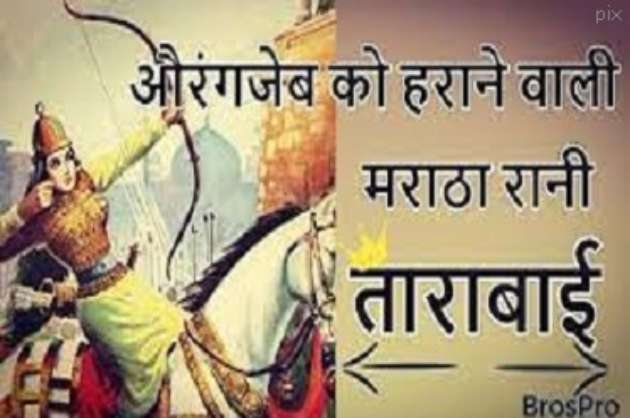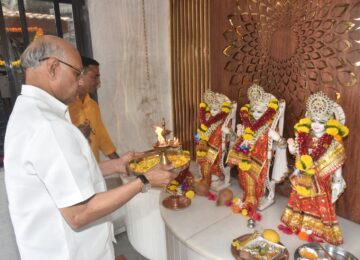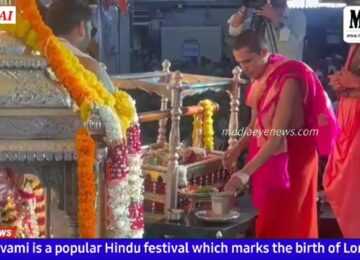Anupama Nair
www.mediaeyenews.com
Our great Prime Minister Modi inaugurated the Amrit Mahotsav or celebration of India’s 75th year of Independence. We will be celebrating this event till 2022. I am going to write a feature on all those great men and women who fought against foreign invasion not just against the British. Today I tell you the story of the brave Maratha queen Tarabai, who defeated Aurangzeb. Have you heard this story before? I am sure the answer would be no, as our history in text books was written mostly by people who were not patriots. There are many dynasties who ruled for centuries, but few invaders who ruled for lesser years got more coverage in our curriculum. Many warriors, especially brave queens were neglected and never included in history. One such brave queen is Tara Bai, the Maratha queen who defeated Aurangzeb.
The legendary queens in India, Egypt, Greek and Roman mythology were warrior women who have fascinated the world from time immemorial. India, too, has its own share of indomitable women who proved themselves to be fierce fighters and skilled leaders. Making military strategies to storming the battlefields, these courageous queens were truly a force to be reckoned with and second to none. Rani Lakshmi Bai, Rani Abbaka Chowta and Kittur Chenamma were three of the more well-known examples. However, there are many more whose stories have been forgotten in the annals of history. Among these unsung warrior women is Tarabai – the brave queen of Marathas.
Considered as one of the bravest women in Indian history, Tarabai was also called the ‘rainha dos Marathas’ or the ‘Queen of the Marathas’ by the Portuguese. She was the daughter-in-law of Chhatrapati Shivaji and one of India’s greatest medieval monarchs. She is among the few women in history to “save a kingdom by her sheer force and willpower, her indefatigable courage and resolute spirit are at par with the legendary Rani Laxmi Bai of Jhansi, Rani Rudramma Devi of Warangal, Rani Abbakka Chowta of Ullal, Rani Chennamma of Kittur and Velu Nachiyar”. However, very little is written about this warrior queen or her incredible story, so I am writing about her today.
Tarabai Bhosale was the daughter of Maratha general Hambirao Mohite. She was married to Rajaram Bhosale, who was the youngest son of Bharat Ma’s greatest son Shivaji Maharaj, when she was only 8 years old. She was a woman who witnessed the rise and fall of the Marathas, as it was an era when the Mughals and the Marathas were constantly at war for control over Deccan. In 1674, Shivaji had been crowned the ruler of the independent Maratha kingdom that was established by him. Under his able leadership, the empire quickly became a key political force in India, surviving at the height of Mughal power.
Unfortunately, Shivaji passed away in 1680, and the Marathas passed through their toughest time. Sambhaji Maharaj the eldest son of Shivaji became the next ruler. In 1689, Sambhaji was captured and tortured to death by Aurangzeb, after Raigad fort fell to a Mughal army of over fifteen thousand. His wife, Yesubai and son, Shahu, were captured and taken to the Mughal court as hostages.
After his death, the Marathas under Rajaram Bhosale continued the war through guerilla tactics. But unfortunately, Rajaram Bhosale died in 1700 due to a chest disease. The Mughals were delighted when they heard the news. However, they underestimated the strength and bravery of Bharat Ma’s daughter and learnt a lesson never to underestimate the great valor of a young Indian queen. There were no legal heirs to the throne, due to this Tarabai Bhosale proclaimed her son Shivaji II as the heir to the throne and successor of Rajaram and declare herself as Queen Regent and took charge of the administrative, judiciary and military powers of the empire.
Though grief-stricken by the loss of her husband, Tarabai did not waste much time on tears. Instead, she threw herself into organizing a well-planned and vigorous opposition to Aurangzeb. In fact, in his book, ‘A Social History of the Deccan’, the famous historian Richard Eaton quoted the following lines said by Khafi Khan who was the court chronicler of the Mughals and the author of Muntkhab al-Lubab “the Mughals felt that it would not be difficult to overcome two young children and a helpless woman. We thought our enemy weak, contemptible and helpless; but Tarabai, as the wife of Ram Raja (Raja Ram), showed great powers of command and government, and from day to day the war spread and the power of the Marathas increased”. She must have been truly great that even enemies praised her valor.
She was an intelligent woman, and had earned a reputation during her husband’s lifetime for her knowledge of “civil, diplomatic and military matters”. She used this knowledge to lead from the front travelling between forts, forging crucial partnerships, mobilizing resources and men. “She was a skilled cavalry warrior and also motivated her commanders and soldiers by personally leading aggressive attacks on the enemy.
In his memoirs, Bhimsen who was an officer in the Mughal army said that Tarabai “was a stronger ruler than her husband” and that Tarabai “became all in all and regulated things so well that not a single Maratha leader acted without her order”.
One of Tarabai’s greatest achievements was that she never stopped learning, even if it was from the enemy. She learnt Aurangzeb’s technique of bribing commanders on the enemy side and then Tarabai and her commanders began attacking all the long-held territories of the Mughal empire like Malwa and Gujarat and appointing their own revenue collectors. Even, when forts of her own fell into Aurangzeb’s control, Tarabai always had control of resources from her permanent collection centers in Mughal domain! In her seven-year period as regent, Tarabai single-handedly directed the Maratha resistance against the massive army of Aurangzeb, then the mightiest ruler in the world.
Under her rule, the Maratha army established their rule over Southern Karnataka and plundered several rich towns of the country’s western coast such as Burhanpur, Surat and Broach. In the midst of repeated failures in suppressing the Maratha resistance, Aurangzeb died in 1707, and after facing a power vacuum at the top, the Mughals cunningly released Shahu whom they had captured along with Shambaji, to divide the Maratha kingdom by sending a new claimant to the throne.
The idea was successful, when Shahu challenged Tarabai and Shivaji II for leadership of the Maratha Confederacy. Tarabai refused, fearing the impact Shahu’s Mughal upbringing may have on his reign. This dispute quickly transformed into a battle. However, given Shahu’s legal claim to the throne, chieftain sent by Tarabai to fight him defected to the other side. However, with the support of Peshwa Balaji Vishwanath’s diplomacy and the new Mughal emperor’s resources, he succeeded in 1708. Tarabai, however refused to accept defeat and established a rival court in Kolhapur the next year but was soon deposed after Shahu and Rajasabai (Rajaram’s second wife) joined forces to put Rajasabai’s son Sambhaji II on the Kolhapur throne. Tarabai and her son Shivaji were thrown into prison, where she spent 16 years and her son eventually died.
However, later Sambhaji II turned hostile, forcing Shahu to switch sides. Shahu freed Tarabai from prison, invited Tarabai to stay in the Satara palace, albeit under house arrest. However, Tarabai’s role in Maratha empire was not over as Tarabai at the age of 73, stepped out of the shadows after Shahu fell seriously ill with no direct descendants of Shivaji to appoint as his heir. Then she revealed her biggest secret — grandson Ramraja, fearing his assassination by Rajasabai and Sambhaji II, and that he was now 22 years old, a Maratha prince waiting for his destiny. So Shahu adopted Ramraja as his heir before he died in 1749. With Tarabai’s help, the young prince ascended the Maratha throne. Unfortunately, he became close to the powerful Peshwa, Nana Sahib, and refused to accede to her wishes, and Tarabai denounced him as her grandson.
The brave queen Tarabai passed away at the age of 86 in 1761, a few months after Ahmad Shah Abdali destroyed the Maratha Army at the 3rd Battle of Panipat. “Had the indomitable queen not taken charge of the Empire in 1701, it is quite likely that the Marathas would have had to face a similar defeat much earlier and the history of India would have been much different”.
“An indomitable warrior queen who was deeply devoted to her kingdom, Tarabai didn’t just prevent the Maratha Confederacy from disintegrating when it was at its lowest ebb, she played a crucial role in it rise to national power by 1760, the Marathas de facto controlled almost all of India”.




























